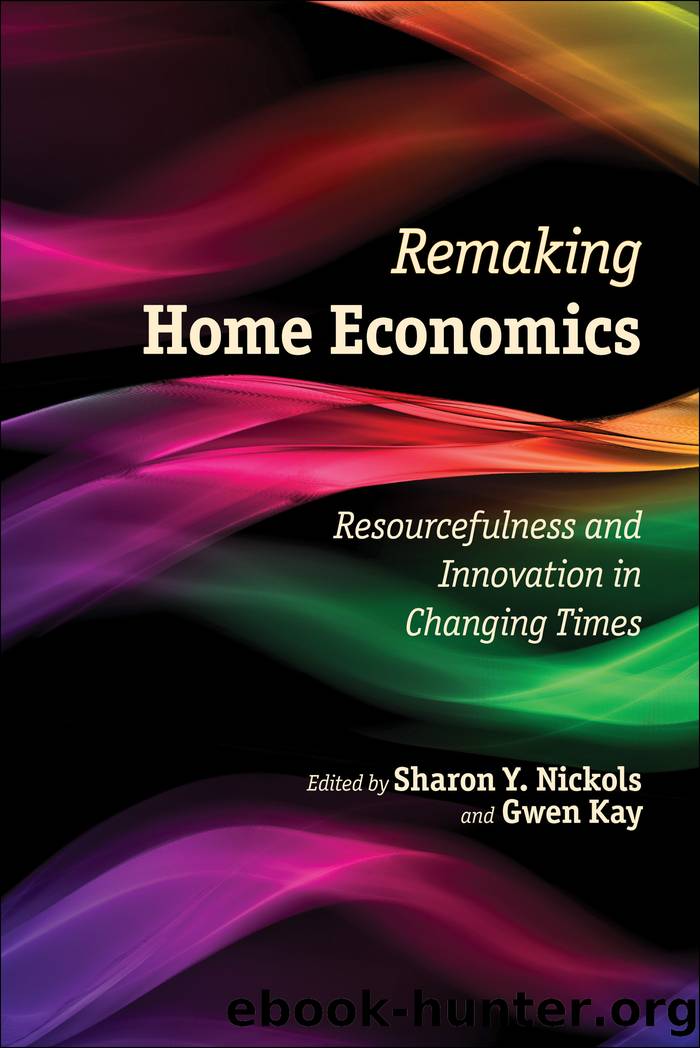Remaking Home Economics by Nickols Sharon Y.;Kay Gwen;

Author:Nickols, Sharon Y.;Kay, Gwen;
Language: eng
Format: epub
Publisher: University of Georgia Press
Published: 2015-08-15T00:00:00+00:00
Democracy in Dress
The essentially democratic character of thrift and appropriate dressing was taught explicitly to home economics students. âEvery girl, especially of high school age, has seen unhappiness inflicted on the plainly dressed student by the supercilious attitude toward her of some better dressed classmate,â explained a textbook from 1919 (McGowan and Waite 1919, 229). This was not right. âThe girl of true American spirit will use her example and influence against such snobbishnessâ (ibid., 229â230). Home economists, including Mary Lockwood Matthews, the founding dean of Purdue Universityâs School of Home Economics, supported a trend in the 1920s for schools to prescribe matching simple white graduation dresses. In Elementary Home Economics she wrote, âA girl never looks appropriately dressed when she wears clothing that may make her companions feel uncomfortable because it is more expensive than that which they are wearingâ (Matthews 1928, 433). One home economics book included in the appendix proof that the girls of North Central High School in Spokane, Washington, had that true American spirit. Their school dress code banned âsatin slippers, high heels, silk and velvet afternoon or party dressesâ in 1925 (Gibson 1927, 307).
According to the home economists, dress could lead any girl or woman to success in life. âBeautiful and becoming clothing that contributes to oneâs attractiveness gives poise and assurance and thus contributes to success,â concluded Buttrick (1925, 162) after noting the natural desire for beauty, which clothing can satisfy. Home economists saw young women as citizens in the making. The scope of ambitions that the educators envisioned for their well-dressed audience in the modern age was expansive. âSince the code of life of the modern girl includes an ideal of health and strength and an ideal of activity and leadership,â explained Buttrick (ibid., 107), âher clothing must contribute to these ideals by giving her freedom of action and the chance to develop all the grace and strength of her body.â In their college textbook, Mildred Graves Ryan and Velma Phillips, the dean of the College of Home Economics at the State College of Washington, made clear their ambitions for their young woman reader: âIt is hoped that through its study she will gain that inner confidence which will allow her to think about something besides herselfâto see herself in relation to the family, the community, and the worldâ (Ryan and Phillips 1954, v). This ambitious message never disappeared. By dressing well, a woman can gain âa basic sense of security and self-respect,â and thus she is released âfrom the tensions caused by concern about her appearanceâ and is free âto give her full attention to more vital matters, for herself and for the welfare of othersâ (McJimsey 1963, 4â5).
Home economics programs on dress were not actual sumptuary laws, but for their era they were nearly the equivalent: a formidable government-sponsored program aimed at teaching American women how to dress. (Incidentally, Hunt [1996] argued that dress codes at work constitute the persistence of sumptuary laws; however, he gave no attention to the work of home economists.
Download
This site does not store any files on its server. We only index and link to content provided by other sites. Please contact the content providers to delete copyright contents if any and email us, we'll remove relevant links or contents immediately.
| Administration | Assessment |
| Educational Psychology | Experimental Methods |
| History | Language Experience Approach |
| Philosophy & Social Aspects | Reform & Policy |
| Research |
The Art of Coaching Workbook by Elena Aguilar(50105)
Trainspotting by Irvine Welsh(21018)
Twilight of the Idols With the Antichrist and Ecce Homo by Friedrich Nietzsche(18297)
Fangirl by Rainbow Rowell(8785)
Periodization Training for Sports by Tudor Bompa(7916)
Change Your Questions, Change Your Life by Marilee Adams(7371)
This Is How You Lose Her by Junot Diaz(6433)
Asking the Right Questions: A Guide to Critical Thinking by M. Neil Browne & Stuart M. Keeley(5355)
Grit by Angela Duckworth(5295)
Red Sparrow by Jason Matthews(5195)
Paper Towns by Green John(4789)
Room 212 by Kate Stewart(4732)
Ken Follett - World without end by Ken Follett(4441)
The Sports Rules Book by Human Kinetics(4077)
Housekeeping by Marilynne Robinson(4059)
Double Down (Diary of a Wimpy Kid Book 11) by Jeff Kinney(3924)
Papillon (English) by Henri Charrière(3902)
Exercise Technique Manual for Resistance Training by National Strength & Conditioning Association(3784)
The Motorcycle Diaries by Ernesto Che Guevara(3782)
